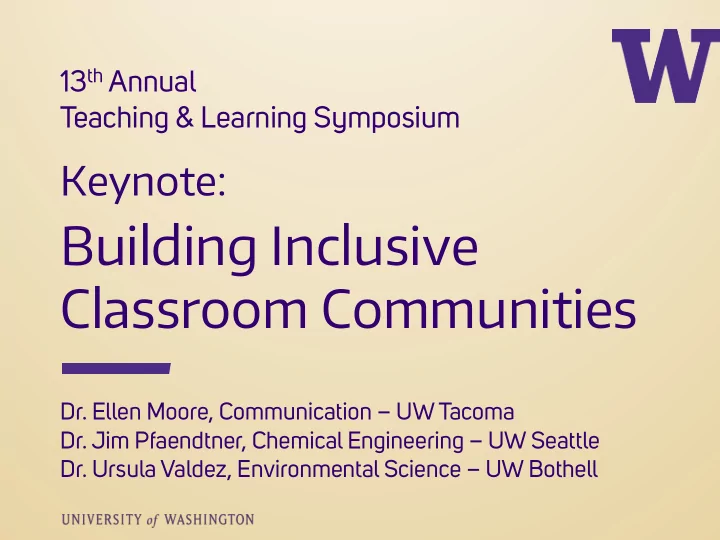

13 th Annual Teaching & Learning Symposium Keynote: Building Inclusive Classroom Communities Dr. Ellen Moore, Communication – UW Tacoma Dr. Jim Pfaendtner, Chemical Engineering – UW Seattle Dr. Ursula Valdez, Environmental Science – UW Bothell
Opening question: What does an inclusive classroom community look like in your context? Write on your index card
Fostering Inclusive Classrooms in Times of Political Tension Dr. Ellen Moore Senior Lecturer - Communication School of Interdisciplinary Arts and Sciences University of Washington Tacoma
“If You Were You” If you were a teacher would you teach your students the truth? make origami birds from the history books fly back in time for the truth? - Penniman & Garcia (2014)
Inclusivity Inclusive environments are: > “characterized by a collective commitment to integrating diverse cultural identities as a source of insight and skill” (Nishii, 2013, p. 1754).
Ada Adapting Jo Joanna Ma Macy’s wo work k fo for bu buildi ding in inclusivity ivity in in th the classro room “Open Questions ” 1. When I found out, I felt the following sensations in my body.... 2. I experienced the following emotions... 3. It brought up the following concern or question that.... 4. It made me want to take the following action(s)....
Reactions from Students > Sm Smiles replacing te tears > Mor More l laughter > Hi High f five ves/h /hugs > Stu Students ts were able to to ta talk with th oth ther st students s whose se views s may y diffe ffer > Bo Bolder, b brave ver s spaces w with thout a t anger o or ju judgm gmen ent and wit ith more e open en co communicat icatio ion
Creating inclusive spaces in the active classroom Dr. Jim Pfaendtner Associate Professor Chemical Engineering University of Washington Seattle
Thermodynamics and inclusivity?! Boltzmann Pfaendtner Ludwig Boltzmann 2013 – 1844-1906 Credited with chasing the cat Credited with development of and outstanding stress-relief ”molecular thermodynamics” properties
You tend to increase the entropy of your surroundings > En Entropy: : how much ch “disorder” is in a a system ( e.g., a classroom environment ) ) > Pr Principle 1: Disordered systems can accomplish many things – but not always what you intend Principle 2: Without additional effort, faculty > Pr will make things more disordered
You control your own destiny about how “entropic” your classrooms are > Pr Prin incip iple le 3: Thermodynamics tells us how to decrease the entropy of a system – you have to put in energy (a.k.a. “work”) > Pr Prin incip iple le 4 : Be careful what you wish for – putting in the wrong kind of “work” can still lead to increasing disorder in your classroom! … I believe the key to getting the most out of your active classroom is maximizing the inclusion of all views, perspectives and personalities … which is often first to go when things get crazy
Task 1: Set the ground rules and stick to them Case study: drawing out multilingual graduate students
Task 2: Unrelenting engagement Case study: getting smart introverts to teach each other engineering
How do you know if you are getting the job done? > Your classrooms are living labs! > Why not use them to conduct experiments and see if your ideas about engagement and inclusivity are working?
Collaborative learning and action to address global environmental issues Dr. Ursula Valdez Lecturer – Environmental Science School of Interdisciplinary Arts and Sciences University of Washington Bothell
Current ecological and environmental problems require sound knowledge & local and global actions Infrastructure Climate Change Gold mining Pollution (garbage, plastic)
“From the Cascades to the Andes: Environmental issues in Peru and the Pacific Northwest” (COIL: Collaborative Online International Learning)
Course Structure > Advanced seminars: 10 week- overlap, 4 Learning modules > Synchronized discussions, online discussions, collaborative research projects, use of study cases > Propose a collaborative action/solution > Public communication: Video, magazine or newspaper article, photo essay, art and science > Letters to politicians > Discussion and field trips with both instructors at each location
Modules: 4 Parallel Stories 1. Biological diversity: regions, species, rainforest (tropical and temperate) 2. Fisheries (Salmon vs. Anchovy) 3. Use of resources and impacts (i.e. logging and deforestation, gold mining, market crashes) 4. Climate change and Mountain ranges (Andes and Cascades)
Collaborative student actions 1. Activism: Campaign for water resources conservation 2.Information booth including remote connection/ video with Peruvian students 3. Open letter to a Peruvian magazine on the state of Columbia Watershed and its relation to Peruvian plans of building river dams
Q& Q&A Dr. Ellen Moore, Communication – UW Tacoma Dr. Jim Pfaendtner, Chemical Engineering – UW Seattle Dr. Ursula Valdez, Environmental Science – UW Bothell
Retu Return rn to to th the o e open ening g qu questio tion ( (in inde dex c x card) ard): What does an inclusive classroom community look like in your context? Adding to what you wrote earlier: What would you add? Change? What questions remain?
Thank you! Poster Session 2 Begins Now! 3:45-4:30
Recommend
More recommend